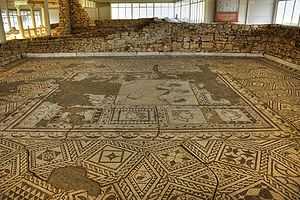Villa Armira

Villa Armira (Bulgarian: Вила “Армира”) is a 1st-century suburban Roman villa in southeastern Bulgaria, located in the proximity of Ivaylovgrad, Haskovo Province. Discovered in 1964 during reservoir construction, it is a primary historical attraction to the Ivaylovgrad area.[1] It is classified as a monument of culture of national importance.[2]
Villa Armira lies some 4 kilometres (2.5 mi) southwest of Ivaylovgrad. It was named after the Armira River, a minor tributary of the Arda. Villa Armira, a sumptuous palace villa, is one of the largest and most richly decorated Ancient Roman villas excavated in Bulgaria. It features rich marble decoration and complex floor mosaics, some geometric and some depicting animals and plants. The villa dates to the second half of the 1st century AD and originally belonged to a noble of Roman Thrace who is thought to have been the governor of the surrounding area. The two-storey U-shaped villa spreads over 3,600 square metres (39,000 sq ft) amidst a garden, with an impluvium in the middle. Villa Armira had 22 separate rooms on the ground floor alone in addition to a panorama terrace. The entire ground floor was covered in elaborately decorated white marble. The villa's floor mosaics display features typical of Ancient Roman art. The mosaics in the master's chamber depict the 2nd century AD owner with his two children: these are the only Roman-era mosaic portraits to be discovered in Bulgaria. A common theme in the villa's decoration is the gorgon Medusa.[2] In the 3rd century AD, Villa Armira was expanded eastward with a triclinium and a hypocaust.[2]
Villa Armira is thought to have been destroyed in the late 4th century, possibly by the Goths some time around the Battle of Adrianople of 378. Today, the 2nd-century mosaic portraits of the owner and his children can be seen in the National Historical Museum in Sofia, the ceramic findings are exhibited in the National Archaeological Museum, while copies of the marble decoration are part of the Kardzhali Regional Historical Museum's fund.[2] The villa itself, with many of the floor mosaics intact, underwent Phare-funded reconstruction and anastylosis and was opened for visitors in 2008.[3]
Gallery
-

Interior view
-

Geometric floor mosaics
References
| Wikimedia Commons has media related to Villa Armira. |
- ↑ Auzias, Dominique; Jean-Paul Labourdette, Anouck Baudoin, Nevena Panayotova (2008). "Ivailovgrad: Points d'intérêt". Le Petit Futé Bulgarie (in French). Petit Futé. p. 276. ISBN 978-2-7469-2141-2.
- ↑ 2.0 2.1 2.2 2.3 "Вила Армира — Паметник на културата с национално значение" (in Bulgarian). Община Ивайловград. Retrieved 2009-08-31.
- ↑ "Вила "Армира" вече е отворена за посетители" (in Bulgarian). Български фактор. 2008-07-25. Retrieved 2009-08-31.
Coordinates: 41°29′56.65″N 26°6′22.55″E / 41.4990694°N 26.1062639°E
